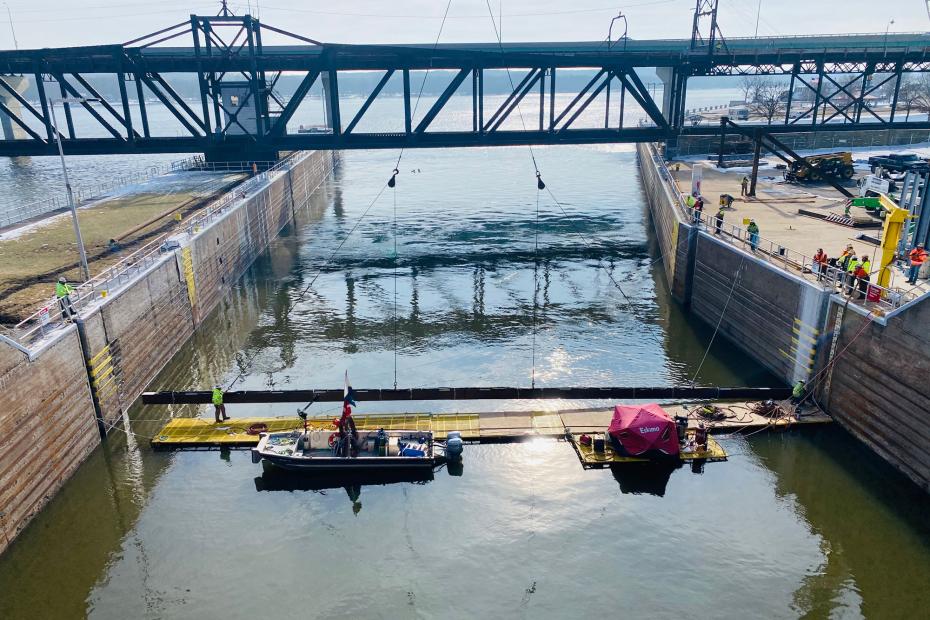Objective, Commitments & Measures
Objective:
2.2. Reduce economic, ecological and human health impacts by limiting range expansion, including lake-to-lake transfers, of non-native species.
Commitments:
2.2.a. Conduct standardized, basin-wide early detection and surveillance activities.
2.2.b. States, Tribes, local governments and non-governmental organizations conduct targeted early detection and surveillance and rapid response actions.
2.2.c. Regional and local organizations sustain containment after initial response projects and complement federal, state and Tribal surveillance.
Measures:
| Measures of Progress With Annual Targets | Baseline/ Universe | FY2025 Target | FY2026 Target | FY2027 Target | FY2028 Target | FY2029 Target |
|---|---|---|---|---|---|---|
| 2.2.1. Percentage of aquatic, high-priority locations for potential new, non-native species occurrence under surveillance. | 65/100 | 65 | 70 | 80 | 85 | 90 |
| 2.2.2. Number of rapid responses, exercises and post-response follow-up activities conducted annually. | 12/N/A | 12 | 12 | 12 | 12 | 12 |
"Targets" are cumulative for measure 2.2.1 but not cumulative for measure 2.2.2. "Baseline" for Measures 2.2.1 is the projected result for end of FY2024. "Baseline" for Measure 2.2.2 identifies regularly expected annual responses, exercises and activities.
Background
Since GLRI began, surveillance programs operating at basin-wide, regional and local levels have been a priority, forming the foundation for a multispecies early detection network. Basin-wide surveillance activities were conducted by the U.S. Fish and Wildlife Service, annually sampling up to 26 hot spots and associated habitats across the basin that are predicted to be locations of greatest risk for new non-native species introductions and establishment. This basin-wide surveillance effort was complemented by state inland lake and stream monitoring to further detect non-native species occurrence and range expansion at locations under pressure by high recreational use or known to have isolated populations of non-native species.
Local partners supported by GLRI complemented basin-wide and state efforts through targeted GLRI projects to contain the spread of non-native species and implement pilot projects to test the effectiveness of control methods. Examples of non-native species that were detected early and are being targeted by GLRI partners to contain or limit spread include European frogbit, hydrilla and red swamp crayfish. GLRI funding also supported states, Tribes and other partners to train staff and conduct rapid responses to reports of new non-native species occurrences. Rapid responses can confirm new occurrences and eradicate or contain isolated populations. In all, 127 GLRI-supported rapid response actions were taken from FY2020-FY2022.
The Great Lakes Commission and The Nature Conservancy annually convened federal, state, Tribal and other entities to share the latest information on non-native species detections within the basin and develop interjurisdictional approaches. These annual forums and regular sharing of lessons learned were critical to cultivating comprehensive approaches to stop the spread of impactful non-native species that are likely to cause economic, ecosystem, or human health impacts (i.e., invasive species). Additionally, the National Oceanic and Atmospheric Administration and the Great Lakes Sea Grant Network continued to use GLRI funding to provide information on the distribution of non-native species through the Great Lakes Aquatic Nonindigenous Species Information System (GLANSIS).
Under GLRI Action Plan IV, frequent sharing of results from surveillance activities and pilot control projects among partners will be critical to ensuring a basin-wide approach to limiting range expansion of non-native species continues. The U.S. Fish and Wildlife Service will maintain and enhance the efficiency of surveillance through its Great Lakes Aquatic Invasive Species Surveillance Program, including annual sampling of new locations. These approaches will increase the probability of detecting non-native species through refinement of current detection strategies and deployment of new sampling technologies and approaches.
Sustained support of states and Tribes will be a key strategy to ensure rapid response, eradication or containment efforts can occur after new detections of non-native species. State and Tribal inland waters surveillance will complement federal surveillance activities to ensure a comprehensive approach to understanding non-native species distributions takes place. Cooperative Invasive Species Management Areas, Partnerships for Regional Invasive Species Management and other local partner organizations will also be supported by GLRI funding under Action Plan IV. These front-line organizations will continue to serve as the “eyes” in the water and on land to help resource agencies understand regional impacts of non-native species and deploy the latest control technologies and approaches.
Forums including the Great Lakes ANS Panel will be places where strategic planning at basin scales will continue. Emerging technologies including metabarcoding eDNA and ballast water treatment systems for Great Lakes commercial vessels will be tested for their utility in widening non-native species surveillance and ability to limit inter-basin spread of non-native species already present, respectively.
Continue reading about the Action Plan IV:






